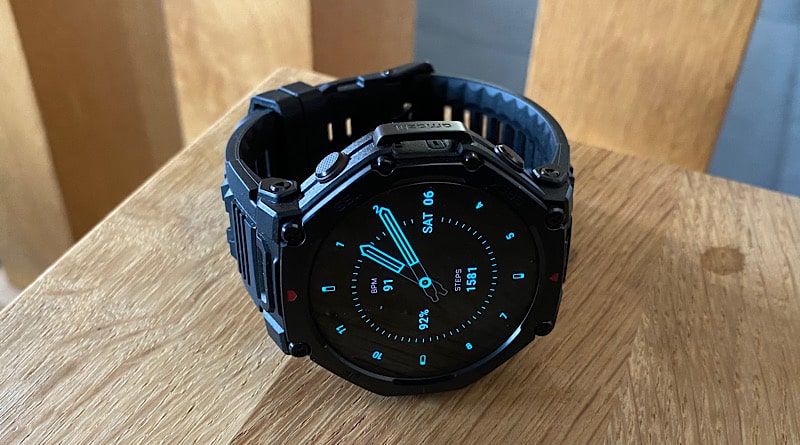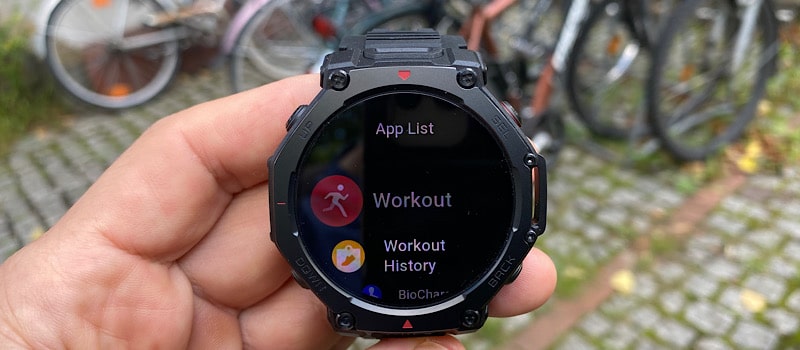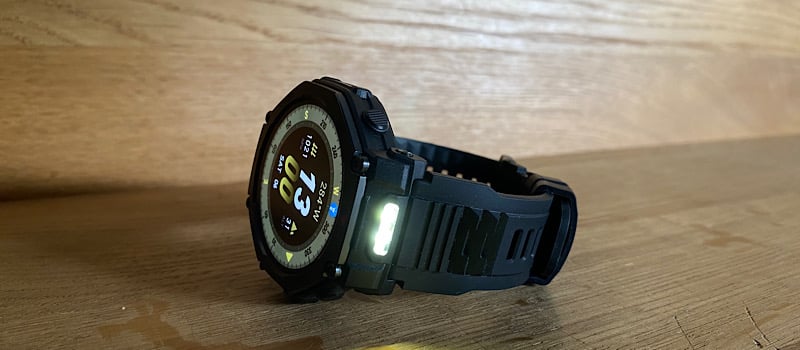
Amazfit T-Rex 3 Pro vs T-Rex 3: Nine key upgrades & what stays the same
I was at the launch event for the Amazfit T-Rex 3 Pro yesterday, which kicked off alongside the opening of IFA in Berlin. The watch comes in two sizes, 48mm and 44mm, and brings a bunch of upgrades over the regular T-Rex 3. You’re getting a tougher titanium bezel and buttons, a sapphire crystal screen, dual-color flashlight, improved mapping features, along with support for Zepp Health’s new BioCharge system.
I’ve started testing the 48mm Pro model (view on Amazfit.com, Amazon), and will share a full hands-on review soon. Until then, here are the 9 key upgrades the T-Rex 3 Pro offers over the standard T-Rex 3, which I reviewed last year and still consider one of the best rugged watches for the money.
1. Two case sizes instead of one
The regular T-Rex 3 only comes in a 48.5 mm case. With the Pro, Amazfit finally gives users a choice. There’s a 48 mm version for those who want the full display size, and a more compact 44 mm model for smaller wrists or anyone who prefers a lighter feel.
The 44 mm Pro trims down both dimensions and thickness, measuring 44.8 × 44.8 × 13.2 mm and weighing 46.8 grams. The 48 mm comes in at 48 × 48 × 14 mm and weighs 52 grams. Compare that to the T-Rex 3, which comes in at 68.3 grams. But that one is a bit thinner, though.
Make no mistake, this is a chunky watch. It is build for the outdoors and is very masculine. It is good the company has finallyintroduced something in the range, that is more suitable for those with slender wrists.
Worth noting is that the Pro models now use standard quick release straps, 22 mm on the 48 mm and 20 mm on the 44 mm. The T-Rex 3 relies on a special tool attachment. I tested the new mechanism and while it can be a bit fiddly, it works well. It’s certainly easier than using a tool, and you don’t have to worry about misplacing anything.
2. Upgraded materials all around
The T-Rex 3 was already solidly built, but the Pro takes things up a notch. Grade 5 titanium alloy replaces stainless steel on the bezel and four buttons. Gorilla Glass is swapped out for sapphire crystal glass. Both models keep a fiber-reinforced polymer case, but the finish is more refined and less plasticky.
These are proper material upgrades. Titanium is both lighter and stronger than steel. Sapphire resists scratches much better, though not fingerprints as I’ve already noticed. Still, the overall build feels ready for rough use while keeping a clean, sharp look.
On your wrist the Pro version definitely feels more premium than its predecessor. Not quite Garmin territory yet, but closing the gap.

3. Up to 3000 nits brightness for daylight visibility
The Pro models push brightness to 3000 nits, compared to the T-Rex 3’s 2000. That bump is noticeable under bright sun, especially when using maps or workout screens. If you’re moving fast and need quick visibility, this is a change you will notice.
Display resolution remains sharp. The 48 mm Pro and the T-Rex 3 both offer 1.5 inch AMOLED panels at 480 × 480 pixels. The 44 mm version steps down slightly to 1.32 inches and 466 × 466 pixels, but keeps clarity and color depth intact.
4. Flashlight built directly into the watch
The flashlight on the T-Rex 3 Pro is a first for Zepp Health. It’s dual-color, built into the side of the case, and genuinely useful. You get a 200-lux white light with adjustable brightness, a red light for preserving night vision, an SOS mode for emergencies, and a Boost Mode that hits 300 lux. That last one is bright enough to light a trail or your tent.
You can switch it on by long pressing the top left button. Then cycle through the modes. Or use the menu to achieve the same.
The standard T-Rex 3 doesn’t have any flashlight functionality. Once you’ve used this in the dark a few times, it’s hard to go back.

5. Better navigation with route planning and rerouting
Both models include offline base maps, ski overlays, and turn-by-turn guidance, but the Pro adds several tools that make navigation feel more complete. You can now tap the map to select a point, search nearby points of interest, and create round-trip or point-to-point routes directly on the watch. If you stray from your planned path, rerouting happens automatically, even without a network connection.
Essential reading: Top fitness trackers and health gadgets
The map visuals have been improved too. There’s better contrast, more terrain detail, and denser road networks. It’s all easier to read at a glance. The Pro also adds check-in points and alerts, giving you more control over longer routes or races. Paired with the same dual-band GPS and six-satellite system as the T-Rex 3, the Pro should offer a stronger wrist-based navigation experience.


6. Better endurance during GPS tracking
Battery life on the T-Rex 3 was already good, but the Pro models tune performance for longer active use. The 48 mm version offers up to 37 hours in precision GPS mode and 82 hours in long GPS battery life mode. The 44 mm Pro delivers 29 and 80 hours in those same modes.
Typical use on the 48 mm Pro is rated at 25 days, and 19 days on the 44 mm. That compares with 27 days for the T-Rex 3. So while the standard model wins slightly on standby, the Pro has the edge when GPS is running.
7. Zepp OS 5.0 with BioCharge tracking
The Pro models ship with Zepp OS 5.0. It brings smoother visuals, better app layout, and most importantly, support for BioCharge. This system tracks your energy levels by looking at recovery, stress, and activity. It gives you a single dynamic score to work with, and it updates throughout the day.
The T-Rex 3 runs Zepp OS 4.5 and doesn’t get BioCharge. You get basic stress and recovery stats, but not the integrated energy tracking. So you still need to rely on the old Recovery Score. Which in my testing is not that great.
8. Mic and speaker for full voice control and calling
The T-Rex 3 includes a microphone for voice assistant support, but that’s it. The Pro adds a speaker, which unlocks full Bluetooth calling from the wrist. You can take or reject calls and speak directly into the watch. It also improves Zepp Flow voice commands, since you get audio responses instead of silent prompts.
It’s a small change, but it makes the watch feel more connected and usable in real life.
9. More sport modes with the same high-end sensors
All three watches use Zepp Health’s BioTracker 6.0 sensor array. That includes a heart rate sensor with five photodiodes and two LEDs, plus temperature, air pressure, SpO2, and the rest of the standard outdoor toolkit. So there doesnt appear to have been any change there.
The 48 mm Pro supports 180 sport modes. The 44 mm and T-Rex 3 support 170.
Bottom line
The T-Rex 3 Pro feels like a proper step up, not just a refresh. You’re getting better materials, brighter display, full navigation upgrades, a built-in flashlight, and smarter recovery tracking with BioCharge. The two case sizes also make it more wearable, especially for people who found previous T-Rex models too bulky. If you spend time outdoors or want more out of your watch without jumping into Garmin territory, the Pro definitely fills that gap.
At $399 (on Amazfit.com, Amazon), it’s quite a bit more than the $279 price tag of the T-Rex 3 Rex 3 Pro starts at $399. Particularly as you will be able to pick up some great discounts on the older version. But you can see where the extra money goes. The T-Rex 3 is still great value and probably the better choice if you just want solid tracking and long battery life without extras. The Pro is for those who want more detail, more durability, and more tools right on the wrist.
Subscribe to our monthly newsletter! Check out our YouTube channel.
Tech specs comparison
Feature | T-Rex 3 Pro 48mm | T-Rex 3 Pro 44mm | T-Rex 3 |
|---|---|---|---|
Launch date | September 2025 | September 2025 | September 2024 |
Dimensions | 48 × 48 × 14 mm | 44.8 × 44.8 × 13.2 mm | 48.5 × 48.5 × 13.75 mm |
Display Size | 1.5 inch AMOLED | 1.32 inch AMOLED | 1.5 inch AMOLED |
Display Resolution | 480 × 480 pixels | 466 × 466 pixels | 480 × 480 pixels |
Brightness | Up to 3000 nits | Up to 3000 nits | 2000 nits |
Display Protection | Sapphire crystal glass | Sapphire crystal glass | Corning Gorilla Glass |
Build | Grade 5 titanium alloy bezel and buttons, fiber-reinforced polymer case | Grade 5 titanium alloy bezel and buttons, fiber-reinforced polymer case | Stainless steel bezel and buttons, fiber-reinforced polymer case |
Buttons | 4 | 4 | 4 |
Strap attachment | 22mm Quick Release | 20mm Quick Release | 22mm Special Tool |
Weight (without strap) | 52 grams | 46.8 grams | 68.3 grams |
Water Resistance | 10 ATM, 45m freediving & scuba certifications | 10 ATM, 45m freediving & scuba certifications | 10 ATM, 45m freediving certification |
Flashlight | Dual-color LED with adjustable brigthness, 200-lux white light, low-interference red light, SOS signal mode, and a 300-lux Boost Mode. | Dual-color LED with adjustable brigthness, 200-lux white light, low-interference red light, SOS signal mode, and a 300-lux Boost Mode. | No |
Satellite Systems | Dual-band GPS, 6 GNSS systems | Dual-band GPS, 6 GNSS systems | Dual-band, 6 satellite systems |
Navigation | Base Maps, Contour, Ski Resort, Turn-by-Turn, POI Search, Route Planning, Round-Trip, Auto Rerouting | Base Maps, Contour, Ski Resort, Turn-by-Turn, POI Search, Route Planning, Round-Trip, Auto Rerouting | Base Maps, Contour, Ski Resort, Turn-by-Turn |
Microphone & Speaker | Yes | Yes | Microphone only |
Bluetooth Calling | Yes | Yes | No |
Connectivity | Bluetooth 5.2 BLE, Wi-Fi 2.4GHz | Bluetooth 5.2 BLE, Wi-Fi 2.4GHz | Bluetooth 5.2 BLE, Wi-Fi 2.4GHz |
NFC | Yes | Yes | Yes |
Music Storage | Yes | Yes | Yes |
Sensors | BioTracker 6.0 PPG biometric sensor (5PD + 2LED), 3-axis acceleration sensor, Gyroscope, Geomagnetic sensor, Air pressure sensor, Temperature sensor, Ambient light | BioTracker 6.0 PPG biometric sensor (5PD + 2LED), 3-axis acceleration sensor, Gyroscope, Geomagnetic sensor, Air pressure sensor, Temperature sensor, Ambient light | BioTracker 6.0 PPG biometric sensor (5PD + 2LED), 3-axis acceleration sensor, Gyroscope, Geomagnetic sensor, Air pressure sensor, Temperature sensor, Ambient light |
Sports modes | 180 | 170 | 170 |
BioCharge support | Yes | Yes | No |
Battery capacity | 700mAh | 640mAh | 700mAh |
Battery Life | Typical use: up to 25 days, heavy use: up to 10 days, precision GPS mode: 37 hours, GPS long battery life mode: 82 hours. | Typical use: up to 19 days, heavy use: up to 7 days, precision GPS mode: 29 hours, GPS long battery life mode: 80 hours. | Up to 27 days (typical), 13 days heavy, 40 days saver |
OS | Zepp OS 5.0 | Zepp OS 5.0 | Zepp OS 4.5 |
Colors | Tactical Black, Black Gold | Black Gold, Arctic Gold | Onyx, Lava, Gray |
Price (USD) | $399 | $399 | $279.99 |
